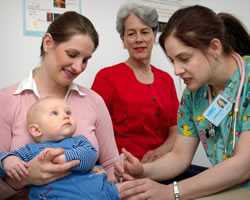Flu Information for Families and Caregivers of Cancer Patients and Survivors

People with flu can spread it to others up to about six feet away. Most experts think that flu viruses are spread mainly by droplets made when people with flu cough, sneeze, or talk. These droplets can land in the mouths or noses of people who are nearby or be inhaled into their lungs. Less often, a person might also get flu by touching a surface or object that has flu virus on it and then touching their own mouth or nose.
Most healthy adults may be able to infect others beginning the day before symptoms develop and five to seven days after becoming sick. That means that you may be able to pass on the flu to someone else before you know you are sick, as well as while you are sick. For more information, learn How Flu Spreads.
Since cancer patients and survivors are at higher risk for complications from the flu, including hospitalization and death, please take the following precautions to help avoid spreading the flu.
- Get a flu shot. CDC recommends a yearly flu vaccine as the first and most important step in protecting against flu viruses.
- Help stop the spread of germs by covering your nose and mouth with a tissue when you cough or sneeze, washing your hands or using hand sanitizer often, avoiding close contact with sick people, and limiting contact with others as much as possible if you get sick.
If you are caring for a cancer patient or survivor who has the flu, please visit Caring for Someone Sick for detailed information about how to care for the sick person while avoiding getting sick yourself.
If you have a child with cancer, read Flu: A Guide for Parents of Children or Adolescents with Chronic Health Conditions [PDF-164KB].
- Page last reviewed: November 18, 2013
- Page last updated: September 26, 2017
- Content source:


 ShareCompartir
ShareCompartir